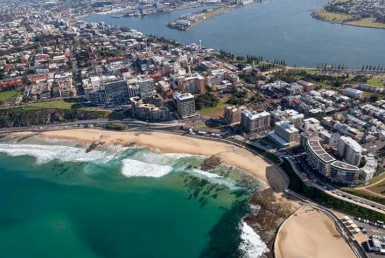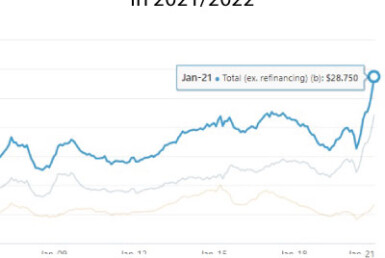QLD Excerpt From The 2014 January Market Report
While Sydney and Melbourne raced ahead during the past 12 months, Brisbane fell behind. So will 2014 be Brisbane’s time to shine?
Vendors waited anxiously for the highly anticipated return of buyers’ interest. They were counting on the recent surge in buying activity in Sydney and Perth spreading to Brisbane’s depressed property market.
Heck, if oversupplied Melbourne has picked up steam, surely Brisbane will follow suit, they thought. Except that it didn’t, leaving some experts scratching their heads.
“We thought there would be some improvements by now,” says Angie Zigomanis, senior research analyst at BIS Shrapnel. “If you look at the data, we thought the market has already bottomed out, but it’s still struggling to gain any traction. We thought by now it would be starting to look a lot more positive.”
John Edwards, founder of Residex, was just as baffled by the unexpected under performance of the Brisbane market. “I’m a bit confused about the Brisbane market’s performance,” he admits. “I thought it would have done better than it has been doing. I don’t really understand why the state and its markets are not doing better than they are.”
So what happened?
A double whammy of fear-inducing cost-cutting measures happened.
When you hit a market on the verge of an upturn with drastic fiscal tightening both by a government anxious to make its mark and by aggressive cost-cutting measures by major companies operating in the state, you will kill a recovery before it even begins.
“Confidence was starting to emerge a year ago, or before that, but it was curtailed by the significant fiscal consolidation policies of the new government,” explains Andrew Wilson, chief economist at Australian Property Monitors.
“There was significant job shedding. We saw unemployment rise to 6% in Brisbane, and that was the clear catalyst for continuing that ‘wait and see’ attitude by the housing market. You’ve got to remember that they had the floods in 2011, and there were a lot of other hits to the Queensland economy and psyche over the last three years but we were starting to see those early signs of a pick-up, but the fiscal consolidation nipped it in the bud.”
Zigomanis points out that the benefits of the mining sector investments haven’t really flowed through to the mainstream Queensland economy, but he agrees that it’s more a case of low confidence than fundamentals that are at play in the Brisbane market.
“The cost-cutting measures had a bigger impact on demand and sentiment than we thought it would. So yes, things just aren’t turning around as quickly as we would like,” he admits.
The outlook for 2014
So what can we expect over the next 12 months? Will things deteriorate further or are we going to see the state catch up with the others?
Our experts say the state is still grappling with a few weak points that it needs to address before it can move strongly forward.
Reasons to be cautious
1.The economy remains weak
Zigomanis expects the weak state economic environment will continue to dampen any recovery of demand in 2013/14, which in turn will limit the recovery of the median house price to just 4%.
“Overall, the Queensland economy is still weak,” he says. “Unemployment rates are higher in Brisbane and Queensland than they are elsewhere on the eastern seaboard.”
2. Poor confidence persists
The job losses brought about by Campbell Newman’s sacking of a whole lot public servants have made people worry about employment prospects, says Zigomanis.
“People are wary. It’s a bit like the Sydney and Perth market. Until you start seeing concrete signs that things have bottomed out and they are starting to improve, people won’t head back into the market.”
3. Interstate migration is easing
Net interstate migration into Queensland, which has fuelled demand for housing over recent years, has started to ease, according to Harley Dale, chief economist at the Housing Industry Association (HIA).
“The level of interstate migration isn’t occurring in this cycle the way historically we have seen it occur. So the level of demand just isn’t there to generate the price gains that we’ve seen in the past,” he says.
In fact, net interstate migration into Queensland has been at a long-term low, while it’s been at a record high in Western Australia, reflecting the economic performance of these states, according to BIS Shrapnel. On a positive note, the economic researcher expects this trend will reverse as housing affordability improves and the state economy picks up again.
4. Coal investments are falling
“The coal industry is not what it once was,” says Dale from the HIA. “The drop in coal mining investment was quite a considerable drag on the Queensland economy overall. You’re just not getting the revenues from coal. The investment cycle has peaked and gone down the other way. That was a big kick in the Queensland economy.”
Unless prices lift, further coal mine closures are possible, which will exacerbate the current low confidence.
5. Uncertainty over major resource-related projects
Deloitte Access Economics’ Investment Monitor says there’s a risk that the astonishing list of projects in the pipeline will fail to make their way on to the state’s equally astonishing list of major resource-related projects currently underway.
There’s currently an eye-popping $71bn worth of resource-related projects underway in the Sunshine State, with a further $54bn worth of projects in the pipeline.
Reasons for optimism
While Brisbane and many parts of Queensland’s property market have struggled to take off, weighed down by the deep cost-cutting measures, our experts are optimistic that the next 12 months will be brighter for the sunshine state. Here are the reasons why:
1. Major cost-cutting already out of the way
Now that the heavy cost-cutting is out of the way, the government can finally focus on growth, says W ilson. “The Newman government will be looking towards election next year; it’s done the heavy lifting and will logically start to spend,” he says.
Shane Oliver, AMP chief economist, agrees and adds that while cost-cutting had an immediate negative impact, he thinks this is just a short-term negative for the state.
“The immediate effects of the public service cuts have been negative, but that situation should ease in time,” Oliver says. “There is strong potential for Brisbane to grow solidly in the future. It will recover as the Australian economy recovers. I think it is definitely starting to catch up with other growth areas.”
2. Lower dollar set to stimulate tourism and agriculture
The falling Aussie dollar is starting to lure tourists back to Australia, and Queensland is primed to grab the lion’s share of those visitors. Our experts believe this will help kick-start the state economy, particularly in the Gold Coast and Sunshine Coast areas. The cheaper dollar is also expected to stimulate agriculture and mining exports, which both suffered at the height of the Aussie-dollar boom.
3. Population is still growing at above-average rate
Queensland’s population growth remains above the national average. During the past 12 months, the population grew by 2.1% to 3.772 million. Deloitte Access Economics expects a similar growth rate in 2014.
4. Signs of confidence returning to the property industry
While there’s still a lot of nervousness in the market, confidence in the property industry is gaining strength, according to the latest Property Council/ANZ Property Survey. Both NSW and Queensland recorded the strongest confidence across all states and territories in the December quarter.
“Low interest rates are gaining traction with the housing market in particular, with both dwelling investment and house prices expected to strengthen in the year ahead,” says David Cannington, ANZ senior property analyst. “This is a positive sign for the broader economy as property will be critical in driving the transition from mining investment.”
Cameron Kusher, senior research analyst at RP Data, thinks the outlook for Brisbane is probably a little better than the other capital cities, thanks to the widening gap in pricing between Brisbane and the Sydney and Melbourne property markets.
“From an investor’s perspective, Brisbane units in particular are getting a really strong rental yield of 5.6%, and even houses at 4.7%, which are a lot better than what you’d get in Sydney and Melbourne and even a market like Perth,” he says. “The fact that essentially prices have gone nowhere for almost seven years now makes it more attractive to investors.”
5. Commonwealth Games expected to boost the economy
Dubbed “the biggest event Australia will see in the next decade”, the 2018 Commonwealth Games is expected to boost the Gold Coast’s economy to the tune of $2bn, according to the state government. It has also already allocated $100m in the state budget to build infrastructure around the event, which is expected to create thousands of jobs in the area.
6. Mining construction still rising
Despite the negative publicity surrounding the mining sector, there are signs that mining construction is rising again, particularly in the Galilee and Surat Basins, according to Wilson.
Among the biggest projects set to start in 2014 include:
- Adani’s proposed $10bn Carmichael Coal Mine
- Up to 5,000 workers needed during construction
- Up to 3,500 workers when operational
- Waratah Coal’s proposed $8.3bn China First Coal Project
- Up to 6,000 workers needed during construction
- Up to 1,500 workers needed when operational
- Hancock’s $6.9bn Alpha Coal Project
- Up to 2,500 workers needed during construction
- Up to 1,600 workers when operational
“We’re a long way from calling the mining boom dead in Queensland,” says Wilson.
“I do believe that the Queensland economy is primed to outperform all the other state economies – particularly given a lower dollar. All the boxes are being ticked for the Queensland economy at the moment, and this will stimulate a recovery in house prices growth. Over next year the city will start to get over its previous price peaks.”
7. Pent-up demand should fuel strong price growth
As the Brisbane market plays catch-up with the Sydney, Melbourne and Perth markets, Wilson is expecting to see stand out performance in the state in terms of price growth.
“I think all the factors are lining in favour of strong price growth prospects for Brisbane property prices. We’re not talking double figures here, and Brisbane is the standout in terms of house price growth next year.”
Zigomanis is equally optimistic about the Brisbane and Queensland markets as he is starting to see positive signs coming from the state.
“Queensland is probably where we saw Perth two years ago,” he says. “We’re starting to see vacancy rates tighten up and fundamentals starting to improve.
“There are pent-up demand and supply pressures there. I guess it’s only a matter of when someone flicks a confidence switch to tell people to go and buy.”
As signs of pressure builds around supply, and with rental vacancy rates now the lowest in the country, Deloitte Access Economics also believes “there is a growing evidence to suggest the recent pick-up in housing may begin to accelerate over the coming year.”
8. Affordability expected to lure investors back into the market
With Brisbane significantly under performing Sydney and Melbourne, it’s becoming more attractive for investors who are priced out of Sydney and Melbourne, says Dale.
“In time, Brisbane’s property market will come back because there’s quite a favourable affordability advantage at play now, because the Brisbane property market has under performed Sydney and Melbourne for quite a considerable time now so there’s now a price advantage there again that has considerably eroded in the last cycle,” he says.



